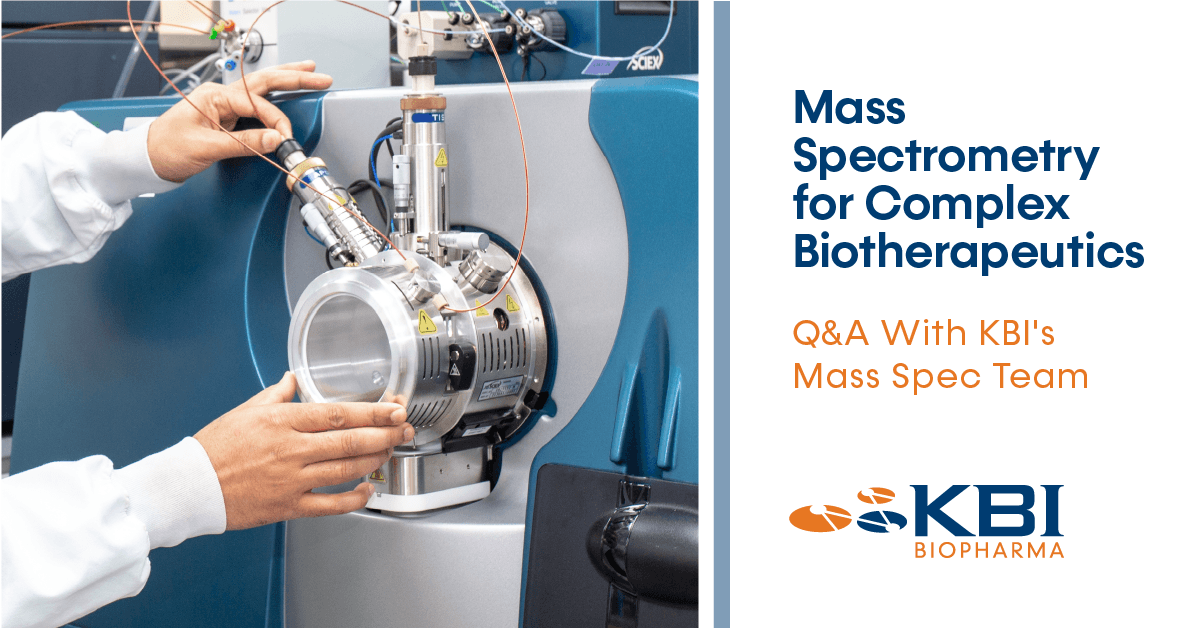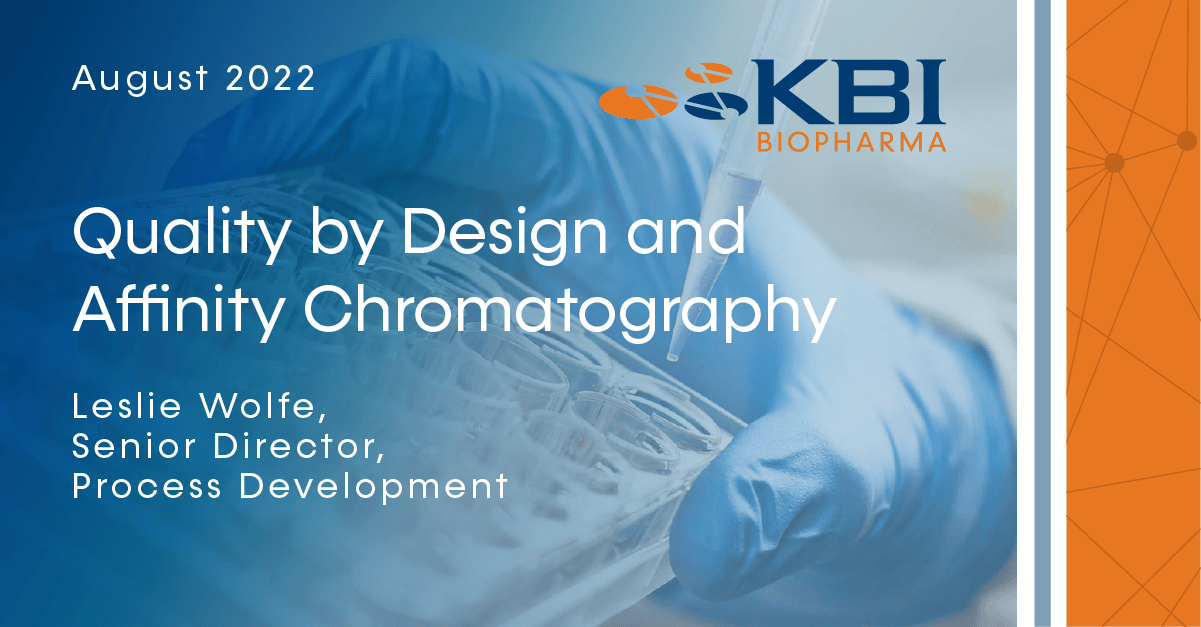3 min read
Mass Spectrometry for Complex Biotherapeutics: Q&A with KBI's Mass Spec Team
CDMOs are becoming increasingly important for developers to reach efficient vaccine and complex biotherapeutic development for their advanced...
5 min read
 KBI Biopharma
Mar 10, 2023 11:52:22 AM
KBI Biopharma
Mar 10, 2023 11:52:22 AM
Increasing global demand for vaccines and complex biotherapeutics has led to a larger role for Contract Development and Manufacturing Organizations (CDMOs), who support the development of these products through all stages from product development to manufacturing. Advanced analytical capabilities, including mass spectrometry, are critical for the characterization of active pharmaceutical ingredients (APIs) and managing a diverse population of impurities. This allows for effective mitigation of safety risks and ensures product quality.
With the ongoing global impact of COVID-19, there has been a rapid rise in both the number of vaccines and biotherapeutics being developed as well as their overall sophistication and complexity. CDMOs have been increasingly leveraged to support the development of these biologics, including analytical support from product development through to manufacturing.
A critical aspect of ensuring biotherapeutic product quality is identifying, monitoring, and controlling impurities. Impurities can result from a wide range of sources, including process-related impurities like host cell DNA and proteins to product-related impurities like degradants, precursors, and aggregates (1).
Advanced analytical methods are vital to characterizing and managing impurities in biotherapeutics, as the broad range of impurities that can be present in complex samples require comprehensive analysis. The structural characterization of impurities is an essential component of biotherapeutic product development. Implementing a thorough strategy for testing impurities can simultaneously reduce the amount of testing needed and meet regulatory requirements, ensuring product quality and patient safety. This information is essential for implementing Quality by Design (QbD), which is applied as early as the initial development of an affinity chromatography step (2).
In vaccine and biotherapeutic development, safety is one of the most important considerations. The development of complex biotherapeutics inevitably includes the presence of impurities (a part of critical quality attributes, or CQAs), which need to be identified, characterized, and assessed.
The presence of impurities could lead to adverse reactions like immunological responses (2), and an impure product could impact the quality, safety, and efficacy of the final product. As such, it is critical to characterize and quantitate the presence of APIs and impurities in complex biological vaccines and therapeutics. Impurities can be either process- or product-related, depending on what they are and where they originate.
Process-related impurities are a result of the manufacturing process. These types of impurities exist and can be increased or decreased depending on the process complexity but are always present to some extent. Common process impurities include host cell proteins (HCPs), host cell DNA, cell culture media components, antibiotics, adventitious and endogenous viruses, chromatographic media from purification steps, buffer components, and solvents. Essentially, these types of impurities are introduced as part of the manufacturing or purification processes.
Product-related impurities are a result of the product itself. Common product impurities include aggregates, truncated and other modified forms of the desired product, precursors, and certain degradation products that arise during manufacture and storage. These types of impurities are introduced as part of the core product.
Impurities are usually present at extremely low concentrations in biopharmaceuticals. Detecting and evaluating complex samples like this requires deep expertise and knowledge of all steps in the bioproduction process, including both upstream and downstream, as well as advanced methodology in analytical testing.
High-resolution mass spectrometry is a powerful tool for analyzing complex samples and is an essential means of characterizing biotherapeutics ahead of regulatory submissions and development milestones (3). Mass spectrometry can aid in identifying and quantitating impurities present in samples from early-stage samples all the way through highly purified drug substances with a level of detail that enables a robust QbD approach to downstream process development.
Advanced mass spectrometry, like that used at KBI Biopharma, can be used for API and impurity characterization. Our systems are set up to use Orbitrap or Quadrupole Time-of-Flight (Q-TOF) technology, which allows for fast scanning speed coupled with high sensitivity in support of highly specific and selective methods for diverse and complementary analytical options.
HCPs are one of the main types of process-related impurities that occur during manufacturing. By using the HCP MS proteomic workflow for process clearance monitoring of HCPs, we can confirm the robustness of clearance steps during purification which allows us to further monitor for any observed hitchhiker effect of proteins that copurify with APIs.
For a recent project supporting the development of a COVID-19 vaccine, for example, we employed a data-independent methodology that used a classical proteomic approach to identify the most abundant HCPs and coproduced viral proteins from transfection. We used this non-cGMP method to screen all the samples that were produced by manufacturers around the world to monitor any variability of background impurity proteins. Working closely with the client, we were able to identify essential impurity proteins to quantitate in addition to the API. This allowed us to then develop, qualify, and validate a cGMP assay using one of our Q-TOF platforms.
High-resolution mass spectrometry is a widely used method for impurity identification. At KBI specifically, our cGMP-compliant, targeted workflows are primarily based on TOF-MRM, a high-resolution multiple reaction monitoring (MRM) method that is a multiplexed form of selective reactive monitoring (SRM). Using this highly specific and sensitive mass spectrometry technique can allow for the selective quantification of compounds within complex mixtures.
Historically, the MRM technique uses a triple quadrupole mass spectrometer that targets precursor ions that correspond to the compound(s) of interest with subsequent fragmentation to multiple product ions, or transitions, with the desired specificity. Only the compounds that meet both the precursor and product ion criteria are then recorded.
By optimizing our specific precursor selection and product ion transmission, we can dramatically increase signal-to-noise. Compared to classical MRM, TOF-MRM increases specificity with high-resolution, accurate mass TOF measurements which result in comparable limits of detection and quantitation.
The equipment and automated workflows, with streamlined instrument control, data processing, and reporting that includes full audit trails, meets the data integrity compliance with 21 CFR Part 11, the U.S. Food and Drug Administration (FDA) rule that governs electronic records and signatures. Our LC-MS systems and workflows also meet the requirements of the European Medicines Agency (EMA), with our facility in Belgium recently reporting another successful audit in December 2022.
When it comes to non-proteinaceous concerns, the TOF-MRM targeted workflow is a common approach, but in some cases, the specificity of the precursor ion measurement is sufficient to meet the quantitative needs. MRM development may not be required and employing a strategy with accurate mass extracted ion chromatogram (EIC) integrations in a non-targeted manner that may be able to save time during process development. Isotope dilution mass spectrometry (IDMS) is a desirable approach for both targeted and non-targeted workflows. Both light and heavy isotope standards can be synthesized for accurate quantitation with these standards being used to generate calibration curves. Spiking the heavy isotope standards into analyte samples allows for measurement corrections, creating relative standard deviations of less than 10% in most cases.
Mass spectrometry is an extremely valuable tool for probing impurities with high resolution, sensitivity, and specificity.
Always-evolving technological innovation in mass spectrometry allows us to see more and dig deeper; better aligning services to evolving regulatory requirements. Improvements in performance with techniques such as ion mobility, electron transfer dissociation (ETD), and ultraviolet photodissociation (UVPD) can support characterization while enabling triage of any issues that may arise from storage and stability. Enhanced sample preparation strategies and automation, chromatographic improvements, state-of-the-art mass spectrometers, and evolving data processing and reporting workflows using cGMP-compliant software all enable profound opportunities for innovation at every step of the analyte life cycle.
At KBI’s Mass Spectrometry Core, we focus on continuous improvement to fully realize technological advances. Through close collaboration with our clients and the needs they present, with our vendors and the technologies and software they introduce, and with our internal teams from process development to formulation, we are always gaining new insight into sources of impurities that need to be understood and accounted for.
Impurities are commonly present in, or generated during, the biomanufacturing process. These impurities, including process or product contaminants, can disrupt biotherapeutic development. At KBI Biopharma, we have deep expertise in the characterization and quantitation of APIs and impurities to support data requirements at every phase of the project cycle. Our state-of-the-art instrumentation and team of experts offer exceptional, reliable results that keep projects on track.
If you are interested in learning more about how KBI’s world-class analytical services are moving biotherapeutics from transfection to clinic, contact us to get in touch with one of our expert team members.
References & Further Reading

3 min read
CDMOs are becoming increasingly important for developers to reach efficient vaccine and complex biotherapeutic development for their advanced...

2 min read
Affinity chromatography is a commonly used technique to isolate biomolecules of interest (e.g., antibodies, enzymes, receptors) and is often a...
1 min read
Woods, R., Xie, H., Von Woods, R., Xie, H., Von Kreuenstein, T., Ng, G., Dixit, S. LC-MS characterization and purity assessment of a prototype...